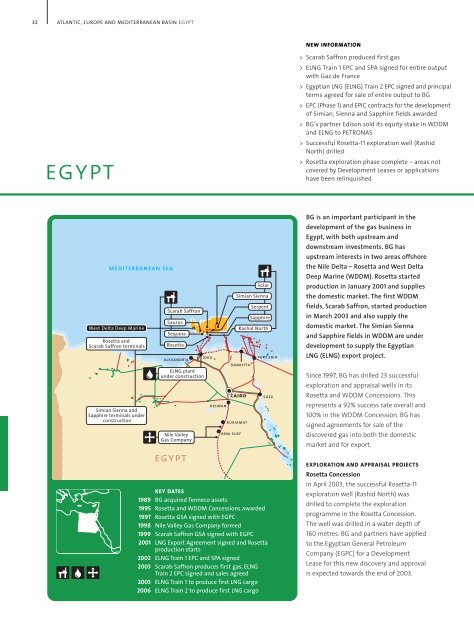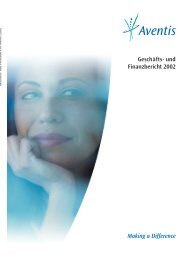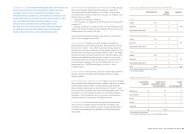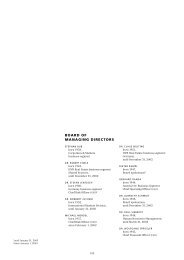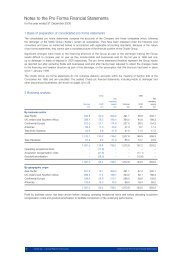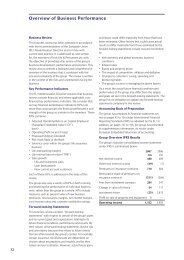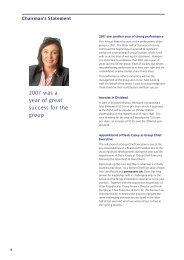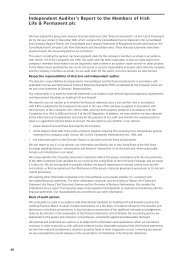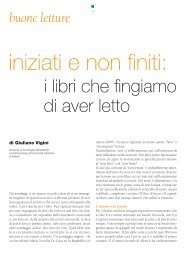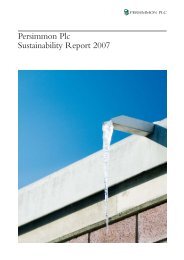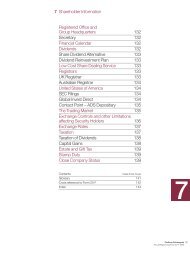Atlantic, Europe and Mediterranean Basin (441 kb) - Investis
Atlantic, Europe and Mediterranean Basin (441 kb) - Investis
Atlantic, Europe and Mediterranean Basin (441 kb) - Investis
Create successful ePaper yourself
Turn your PDF publications into a flip-book with our unique Google optimized e-Paper software.
32 ATLANTIC, EUROPE AND MEDITERRANEAN BASIN EGYPT<br />
egypt<br />
mediterranean sea<br />
West Delta Deep Marine<br />
Rosetta <strong>and</strong><br />
Scarab Saffron terminals<br />
Simian Sienna <strong>and</strong><br />
Sapphire terminals under<br />
construction<br />
Scarab Saffron<br />
Saurus<br />
Sequoia<br />
Rosetta<br />
alex<strong>and</strong>ria<br />
ELNG plant<br />
under construction<br />
Nile Valley<br />
Gas Company<br />
egypt<br />
idku<br />
helwan<br />
damietta<br />
cairo<br />
kuriamat<br />
beni suef<br />
Solar<br />
Simian Sienna<br />
Serpent<br />
Sapphire<br />
Rashid North<br />
port said<br />
KEY DATES<br />
1989 BG acquired Tenneco assets<br />
1995 Rosetta <strong>and</strong> WDDM Concessions awarded<br />
1997 Rosetta GSA signed with EGPC<br />
1998 Nile Valley Gas Company formed<br />
1999 Scarab Saffron GSA signed with EGPC<br />
2001 LNG Export Agreement signed <strong>and</strong> Rosetta<br />
production starts<br />
2002 ELNG Train 1 EPC <strong>and</strong> SPA signed<br />
2003 Scarab Saffron produces first gas, ELNG<br />
Train 2 EPC signed <strong>and</strong> sales agreed<br />
2005 ELNG Train 1 to produce first LNG cargo<br />
2006 ELNG Train 2 to produce first LNG cargo<br />
suez<br />
NEW INFORMATION<br />
> Scarab Saffron produced first gas<br />
> ELNG Train 1 EPC <strong>and</strong> SPA signed for entire output<br />
with Gaz de France<br />
> Egyptian LNG (ELNG) Train 2 EPC signed <strong>and</strong> principal<br />
terms agreed for sale of entire output to BG<br />
> EPC (Phase 1) <strong>and</strong> EPIC contracts for the development<br />
of Simian, Sienna <strong>and</strong> Sapphire fields awarded<br />
> BG’s partner Edison sold its equity stake in WDDM<br />
<strong>and</strong> ELNG to PETRONAS<br />
> Successful Rosetta-11 exploration well (Rashid<br />
North) drilled<br />
> Rosetta exploration phase complete – areas not<br />
covered by Development Leases or applications<br />
have been relinquished<br />
BG is an important participant in the<br />
development of the gas business in<br />
Egypt, with both upstream <strong>and</strong><br />
downstream investments. BG has<br />
upstream interests in two areas offshore<br />
the Nile Delta – Rosetta <strong>and</strong> West Delta<br />
Deep Marine (WDDM). Rosetta started<br />
production in January 2001 <strong>and</strong> supplies<br />
the domestic market. The first WDDM<br />
fields, Scarab Saffron, started production<br />
in March 2003 <strong>and</strong> also supply the<br />
domestic market. The Simian Sienna<br />
<strong>and</strong> Sapphire fields in WDDM are under<br />
development to supply the Egyptian<br />
LNG (ELNG) export project.<br />
Since 1997, BG has drilled 23 successful<br />
exploration <strong>and</strong> appraisal wells in its<br />
Rosetta <strong>and</strong> WDDM Concessions. This<br />
represents a 92% success rate overall <strong>and</strong><br />
100% in the WDDM Concession. BG has<br />
signed agreements for sale of the<br />
discovered gas into both the domestic<br />
market <strong>and</strong> for export.<br />
EXPLORATION AND APPRAISAL PROJECTS<br />
Rosetta Concession<br />
In April 2003, the successful Rosetta-11<br />
exploration well (Rashid North) was<br />
drilled to complete the exploration<br />
programme in the Rosetta Concession.<br />
The well was drilled in a water depth of<br />
160 metres. BG <strong>and</strong> partners have applied<br />
to the Egyptian General Petroleum<br />
Company (EGPC) for a Development<br />
Lease for this new discovery <strong>and</strong> approval<br />
is expected towards the end of 2003.
50<br />
20<br />
40<br />
50<br />
40<br />
40<br />
Partners (%) Rosetta Concession<br />
BG (operator)<br />
40 Shell<br />
20 Edison International<br />
50<br />
Partners (%) WDDM Concession<br />
BG (operator)<br />
50 PETRONAS<br />
West Delta Deep Marine Concession<br />
(WDDM)<br />
Since the Concession was awarded in 1995,<br />
BG has drilled 16 successful exploration<br />
<strong>and</strong> appraisal wells in WDDM – a 100%<br />
success rate. BG has also conducted an<br />
extensive seismic acquisition programme<br />
– a total of 4 910 sq km of 3D seismic,<br />
together with 4 900 sq km of 2D seismic<br />
has been shot. In August 2002, 1 225 sq km<br />
of the 3D seismic was acquired <strong>and</strong><br />
evaluation of this data will form the<br />
basis of future exploration activity<br />
in the Concession.<br />
This exploration programme has resulted<br />
in the discovery of nine gas fields – Scarab,<br />
Saffron, Simian, Sienna, Sapphire, Serpent,<br />
Saurus, Sequoia <strong>and</strong> Solar. The Sapphire<br />
field also contains significant quantities<br />
of condensate. The Sapphire-1 well, drilled<br />
in July 2000, flowed at 35 mmscfd of gas<br />
<strong>and</strong> 1 100 bbls of condensate per day. In<br />
December 2000, the Sapphire-2 appraisal<br />
well confirmed the presence of<br />
significant volumes of condensate in the<br />
Sapphire accumulation. In 2001, a further<br />
successful appraisal well, Sapphire-3<br />
was drilled, confirming the largest gas<br />
column recorded to date in Egypt.<br />
A new discovery in 2002, the Solar field,<br />
<strong>and</strong> two further successful appraisal<br />
wells underlined the prolific nature of the<br />
WDDM Concession. The Solar-1 well was<br />
completed in January 2002 after being<br />
drilled in 1 046 metres of water. The<br />
Sapphire-4 well, drilled in a water depth<br />
of 488 metres, confirmed the north-east<br />
extension of the Sapphire field. In April<br />
2002, the Sienna-2 well, drilled in a water<br />
depth of 991 metres, confirmed the<br />
extent of the Sienna field. This well<br />
marked the completion of the latest<br />
appraisal programme <strong>and</strong> confirmed<br />
sufficient reserves to underpin the<br />
marketing of ELNG Train 2. With the<br />
exception of Solar, all WDDM discoveries<br />
to date have been captured in<br />
Development Leases.<br />
In April 2003, BG’s partner in WDDM,<br />
Edison International, announced the sale<br />
of its 50% interest in the Concession to<br />
the Malaysian oil <strong>and</strong> gas company<br />
PETRONAS. The sale completed in June<br />
2003 <strong>and</strong> was effective from 1 January<br />
2003. BG remains the Concession operator.<br />
UPSTREAM DEVELOPMENT PROJECTS<br />
Rosetta<br />
BG <strong>and</strong> its partners, Shell <strong>and</strong> Edison<br />
International, signed a 25 year Gas Sales<br />
Agreement (GSA) in October 1997 with<br />
EGPC, to supply gas from the Rosetta<br />
Concession into the domestic market.<br />
EGPC received first gas from Rosetta on<br />
31 January 2001, just 45 months from first<br />
discovery in April 1997. The initial stage<br />
of the Rosetta development consists of<br />
six wells tied back to a ‘not normally<br />
manned’ platform with a 66 km gas <strong>and</strong><br />
condensate pipeline to the onshore<br />
terminal, for delivery into the national<br />
grid system near Idku, east of Alex<strong>and</strong>ria.<br />
A joint venture company, Rashid Petroleum<br />
Company, conducts operations on behalf<br />
of the Rosetta partners <strong>and</strong> EGPC.<br />
Since the Rosetta Concession award in<br />
1995, BG has undertaken gross capital<br />
20<br />
25<br />
10<br />
50<br />
50<br />
20<br />
25<br />
ATLANTIC, EUROPE AND MEDITERRANEAN BASIN EGYPT 33<br />
20<br />
Partners (%) Rashid Petroleum Company<br />
BG<br />
50 EGPC<br />
20 Shell<br />
10 Edison International<br />
25<br />
Partners (%) Burullus Gas Company<br />
BG<br />
50 EGPC<br />
25 PETRONAS<br />
expenditure of $314 million to realise the<br />
first phase of development. During 2002,<br />
Rosetta produced a total of 99.1 bcf of<br />
gas (21.6 bcf net BG). Rosetta has shown<br />
that it is capable of producing up to<br />
335 mmscfd, well above its Daily Contract<br />
Quantity (DCQ) of 275 mmscfd. It has<br />
continued to prove a flexible <strong>and</strong> reliable<br />
source of gas to the Egyptian domestic<br />
market <strong>and</strong> has been able to realise<br />
opportunities to produce above the DCQ<br />
during periods of high dem<strong>and</strong>. This<br />
helped Rosetta achieve an average rate<br />
above the 75% of the Annual Contract<br />
Quantity (ACQ) minimum contractual<br />
take level in 2002.<br />
Phase 2 of the Rosetta development<br />
will consist of an unmanned minimum<br />
facilities wellhead platform tied back to<br />
the existing Rosetta platform. The project<br />
FEED work started in March 2003 <strong>and</strong><br />
first gas from the project is scheduled<br />
for the fourth quarter of 2005.<br />
Scarab Saffron<br />
Delivery of first gas from the Scarab<br />
Saffron development occurred on<br />
29 March 2003. Scarab Saffron supplies<br />
gas to the domestic market under a<br />
GSA signed in August 1999 with EGPC.<br />
Under an amendment to the GSA signed<br />
in December 2002, the initial DCQ will<br />
be 440 mmscfd upon completion of the<br />
90 day run in period. On 1 January 2004,<br />
the DCQ will rise to 586 mmscfd for one<br />
year <strong>and</strong> then will rise again at the start<br />
of 2005 to 626 mmscfd. On 1 January<br />
2006, the DCQ will decrease to 533 mmscfd<br />
unless three months have already
34 ATLANTIC, EUROPE AND MEDITERRANEAN BASIN EGYPT<br />
12<br />
12<br />
12<br />
12<br />
38<br />
5<br />
35.5<br />
35.5<br />
38<br />
egypt continued<br />
elapsed since the first shipment from<br />
ELNG, as the DCQ will then rise an<br />
additional 100 mmscfd to 633 mmscfd<br />
for seven years.<br />
The Scarab Saffron fields are larger <strong>and</strong><br />
in deeper water (in excess of 700 metres)<br />
than any other gas fields so far developed<br />
in Egypt <strong>and</strong> are the first to be developed<br />
using sub-sea completion technology.<br />
The Scarab Saffron development consists<br />
of eight sub-sea wells tied into a pipeline<br />
end manifold that is in turn tied back to<br />
an onshore terminal by two gas pipelines<br />
– 36-inch <strong>and</strong> 24-inch export pipelines.<br />
This additional pipeline capacity has<br />
been installed to allow subsequent field<br />
developments to tie into the Scarab<br />
Saffron facilities. Field operations are<br />
controlled from the onshore terminal via<br />
electrical <strong>and</strong> hydraulic umbilical lines.<br />
Burullus Gas Company, a joint venture<br />
company consisting of BG, EGPC <strong>and</strong><br />
PETRONAS, is undertaking exploration<br />
<strong>and</strong> field development operations on<br />
behalf of the WDDM Concession holders.<br />
Export Development Projects<br />
In April 2001, a fully termed agreement<br />
was signed with EGPC, setting the<br />
commercial foundation for the<br />
development of a LNG export project.<br />
The agreement includes amendments<br />
to the existing WDDM Concession<br />
Agreement <strong>and</strong> the GSA. The Egyptian<br />
People’s Assembly ratified the amended<br />
Concession Agreement in March 2002.<br />
Shareholders (%) ELNG Holding,<br />
Operating <strong>and</strong> Train 1 Companies<br />
35.5 BG<br />
35.5 PETRONAS<br />
12 EGPC<br />
12 Egyptian Natural Gas Holding Company (EGAS)<br />
5 Gaz de France<br />
38<br />
Shareholders (%) in ELNG Train 2 Company<br />
BG<br />
38 PETRONAS<br />
12 EGPC<br />
12 EGAS<br />
BG <strong>and</strong> its partner are therefore the first,<br />
<strong>and</strong> currently only, upstream players in<br />
Egypt with a definitive export agreement<br />
allowing the export of gas from a<br />
development within a concession area.<br />
The amendments to the WDDM<br />
Concession Agreement also introduced<br />
a floor <strong>and</strong> ceiling price to domestic gas<br />
sales. At Brent oil prices below $10/bbl,<br />
the floor price payable for domestic gas<br />
is $1.50/mmbtu <strong>and</strong> a ceiling price of<br />
$2.65/mmbtu applies when Brent is<br />
above $20/bbl. This pricing arrangement<br />
was adopted simultaneously for the<br />
Rosetta Development Leases <strong>and</strong> has<br />
been adhered to since production on<br />
Rosetta commenced.<br />
As part of the Scarab Saffron<br />
development, sufficiently large offshore<br />
pipelines have been installed to support<br />
a two-train LNG development, in addition<br />
to supplies to the domestic market from<br />
the Scarab Saffron fields.<br />
Simian Sienna <strong>and</strong> Sapphire<br />
The Simian Sienna fields are being<br />
developed to supply gas to Train 1 of the<br />
ELNG export project whilst the Sapphire<br />
field will supply Train 2. Development of<br />
the Simian Sienna <strong>and</strong> Sapphire fields<br />
will be integrated with the Scarab<br />
Saffron fields to maximise synergies<br />
<strong>and</strong> reduce development costs through<br />
st<strong>and</strong>ardisation of equipment <strong>and</strong><br />
optimising facilities capacity. Like the<br />
Scarab Saffron project, they will use<br />
sub-sea completion technology but due<br />
to the increased step-out from the shore,<br />
the project will utilise a shallow water<br />
controls platform to reduce controls system<br />
risks <strong>and</strong> maintain plant availability. EPIC<br />
20<br />
5<br />
37.5<br />
37.5<br />
Shareholders (%) NVGC<br />
37.5 BG<br />
37.5 Edison International<br />
20 Orascom<br />
5 Middle East Gas Association<br />
<strong>and</strong> EPC contracts have been awarded<br />
to develop the offshore <strong>and</strong> onshore<br />
facilities for the three fields.<br />
DOWNSTREAM PROJECTS<br />
Egyptian LNG (ELNG)<br />
The ELNG Train 1 <strong>and</strong> Train 2 plants <strong>and</strong><br />
common facilities are under construction<br />
in their own Tax Free Zone near Idku.<br />
The zone is adjacent to the Rosetta <strong>and</strong><br />
Scarab Saffron facilities where gas from<br />
BG’s fields enters the Egyptian national<br />
gas transmission system. The $1.35 billion<br />
first train is designed to produce 3.6 mtpa<br />
of LNG <strong>and</strong> the second train is expected<br />
to double the plant’s capacity. The<br />
two-train development is expected to<br />
cost approximately $1.9 billion. Both trains<br />
will be built using the Phillips liquefaction<br />
technology <strong>and</strong> they will share storage<br />
<strong>and</strong> marine facilities. The site can<br />
accommodate up to six LNG trains <strong>and</strong><br />
a multiple company structure has been<br />
selected by the sponsors to give<br />
maximum flexibility for future expansions.<br />
It is designed to allow other gas producers<br />
in Egypt to invest in future LNG export<br />
gas trains, without having to replicate<br />
supporting infrastructure. Additionally,<br />
it is intended to make future expansions<br />
of the ELNG project easier to finance.<br />
The ELNG Holding Company will own<br />
both the ELNG site <strong>and</strong> common facilities,<br />
such as storage tanks <strong>and</strong> jetty. An<br />
operating company will undertake<br />
operations of all trains, although separate<br />
companies will own the individual trains.<br />
The ELNG Train 1 Company will borrow<br />
the required funds <strong>and</strong> build <strong>and</strong> own
Train 1. The ELNG Train 2 Company is in<br />
the process of being formed <strong>and</strong> will do<br />
the same in relation to Train 2.<br />
Following a Heads of Terms agreement<br />
signed in January 2002, a LNG Sale <strong>and</strong><br />
Purchase Agreement was signed in<br />
October 2002 for the sale of the entire<br />
output of the 3.6 mtpa first train to Gaz<br />
de France. Train 1 is scheduled to start<br />
production in the second half of 2005.<br />
In parallel to the commercial framework,<br />
construction of Train 1 <strong>and</strong> the common<br />
facilities started with an early works<br />
programme in May 2002 <strong>and</strong> the full<br />
EPC contract with Bechtel was signed in<br />
September 2002. BG <strong>and</strong> its partners also<br />
made progress securing project finance<br />
of $1.15 billion for the construction of<br />
Train 1 <strong>and</strong> common facilities with the<br />
announcement in January 2003 of the<br />
appointment of 12 international <strong>and</strong><br />
three Egyptian banks as International<br />
<strong>and</strong> Egyptian M<strong>and</strong>ated Lead Arrangers<br />
respectively.<br />
At the same time as purchasing Edison’s<br />
stake in the WDDM Concession, PETRONAS<br />
also purchased its stake in the ELNG<br />
project in June 2003.<br />
Construction of Train 2 started in<br />
May 2003. Early works commenced in<br />
December 2002. In June 2003, BG <strong>and</strong> its<br />
partners agreed principal terms for the<br />
sale of the whole of Train 2 output to BG<br />
Gas Marketing, a subsidiary of BG Group.<br />
At the same time, the ELNG partners<br />
signed the full EPC contract for Train 2 with<br />
Bechtel. Train 2 is expected to start LNG<br />
production in mid 2006. For approximately<br />
the first year of production, the entire<br />
output is intended to supply the Lake<br />
Charles LNG import terminal in Louisiana,<br />
USA. After that time, Train 2 volumes<br />
can be switched to supply the proposed<br />
LNG import terminal at Brindisi, Italy,<br />
which is being developed by BG <strong>and</strong><br />
Enel (see page 39).<br />
Nile Valley Gas Company (NVGC)<br />
In 1998, BG <strong>and</strong> its partners signed a<br />
25 year franchise agreement with EGPC<br />
for the exclusive right to develop the<br />
gas market in Upper Egypt. Formed in<br />
September 1998 with BG as the lead<br />
participant, the Nile Valley Gas Company<br />
(NVGC) is undertaking development of<br />
the gas market <strong>and</strong> infrastructure in<br />
Upper Egypt, focusing around Beni Suef.<br />
Phase 1, costing $38 million, has extended<br />
the gas transmission network from south<br />
of Kuriamat to Beni Suef, with first gas<br />
deliveries achieved in March 1999. During<br />
Phase 1, NVGC contracted with over<br />
17 000 domestic customers <strong>and</strong> a number<br />
of major industrial users.<br />
Further information on the Nile Valley<br />
Gas Company can be found on its<br />
website, www.nilevalleygasco.com<br />
ATLANTIC, EUROPE AND MEDITERRANEAN BASIN EGYPT 35<br />
800<br />
600<br />
400<br />
200<br />
0<br />
Scarab Saffron DCQ<br />
(mmscfd)<br />
Until<br />
end 03<br />
1 Jan<br />
04<br />
1 Jan<br />
05<br />
1 Jan*<br />
06<br />
* DCQ of 533 mmscfd unless 3 months have elapsed since first<br />
ELNG shipment – will then be 633 mmscfd for 7 years<br />
NOTES
36 ATLANTIC, EUROPE AND MEDITERRANEAN BASIN ISRAEL AND AREAS OF PALESTINIAN AUTHORITY<br />
israel <strong>and</strong><br />
areas of palestinian<br />
authority<br />
Matan (309 – Block Gal B)<br />
Michal (308 – Block Gal A)<br />
mediterranean sea<br />
Offshore Gaza<br />
Gaza Marine<br />
egypt<br />
Or<br />
Med Yavne<br />
lebanon<br />
israel<br />
gaza<br />
KEY DATES<br />
1999 BG acquired the Gal preliminary permits,<br />
Med licences <strong>and</strong> offshore Gaza licence<br />
Or gas discovery<br />
2000 3D seismic shot over the offshore Gaza <strong>and</strong><br />
Med licences<br />
Gaza Marine gas discovery<br />
2001 3D seismic shot over the Gal licences<br />
2002 Additional 2D seismic shot over the offshore<br />
Gaza licence<br />
NEW INFORMATION<br />
> Following the withdrawal of various partners<br />
from the Gal Licences, BG <strong>and</strong> the other<br />
continuing parties are actively seeking a<br />
new partner<br />
> Offshore Gaza exploration well deferred<br />
until 2004 pending the successful<br />
commercialisation of the Gaza Marine field<br />
BG has been active in the region since<br />
1999 <strong>and</strong> current activities are focused<br />
upon the successful commercialisation<br />
of its offshore gas discoveries, led by the<br />
largest reservoir Gaza Marine. Gas sales<br />
negotiations with major power <strong>and</strong><br />
industrial users in Israel are being<br />
pursued, whilst on the downstream side<br />
BG is lending its expertise to assist in<br />
the establishment of gas infrastructure<br />
across Israel <strong>and</strong> the Areas of<br />
Palestinian Authority.<br />
ISRAEL<br />
Med Yavne Lease<br />
BG rationalised its interests in the Med<br />
licences in 2002, following the earlier<br />
acquisition, processing <strong>and</strong> interpretation<br />
of seismic data. BG retains operatorship<br />
of the Med Yavne lease, which was<br />
reduced to an area of 52.3 sq km around<br />
the Or gas discovery made in 1999.<br />
Gal Licences<br />
BG is operator of two offshore<br />
exploration blocks, Matan <strong>and</strong> Michal.<br />
Early in 2003, IPE <strong>and</strong> Granit-Sonol<br />
withdrew from the licences <strong>and</strong> other<br />
partners reduced their interest.<br />
Consequently, the continuing parties<br />
are actively seeking a new partner to<br />
participate in the licences, including the<br />
planned deep water 1 600m exploration<br />
well on the Matan licence.
13.2<br />
39.8<br />
1.8<br />
8.0<br />
5<br />
42.0<br />
6<br />
35.0<br />
25<br />
19.2<br />
AREAS OF THE PALESTINIAN AUTHORITY<br />
Offshore Gaza<br />
5<br />
35.0<br />
Partners (%) Med Yavne<br />
BG (operator)<br />
42.0 Isramco Group<br />
13.2 Middle East Energy<br />
8.0 Delek Drilling Limited<br />
1.8 Dor Gas<br />
25.0<br />
Partners (%) Matan <strong>and</strong> Michal<br />
BG (operator)<br />
5.0 Isramco Group<br />
19.2 Middle East Energy<br />
6.0 STX (2000)<br />
5.0 Dor Gas<br />
39.8 Unallocated<br />
Following acquisition of over 1 000 sq km<br />
of 3D seismic data, BG drilled two<br />
successful wells in the second half of<br />
2000 (Gaza Marine-1 <strong>and</strong> Gaza Marine-2).<br />
The first of these tested 37 mmscfd of<br />
gas on a 48/64" choke with the flow rate<br />
constrained by testing equipment. The<br />
second well was not tested but confirmed<br />
a major gas discovery in the Gaza Marine<br />
field. In 2001, a major technical review<br />
recommended development via sub-sea<br />
wells <strong>and</strong> a pipeline to an onshore<br />
processing terminal, incorporating similar<br />
technologies to BG’s Scarab Saffron<br />
development offshore Egypt.<br />
During November <strong>and</strong> December 2002,<br />
BG acquired an additional 925 km of 2D<br />
seismic data in order to better evaluate<br />
the area between the existing discoveries<br />
<strong>and</strong> the shore. The offshore Gaza<br />
exploration well that was planned for<br />
2003 has now been deferred until 2004,<br />
pending the successful commercialisation<br />
of the Gaza Marine field. BG currently<br />
holds 90% equity in the licence, which<br />
will be reduced to 60% after<br />
Consolidated Contractors Company<br />
<strong>and</strong> the Palestine Investment Fund<br />
exercise their options.<br />
ATLANTIC, EUROPE AND MEDITERRANEAN BASIN ISRAEL AND AREAS OF PALESTINIAN AUTHORITY 37<br />
10<br />
90<br />
90<br />
Partners (%) Offshore Gaza<br />
BG (operator)<br />
10 Consolidated Contractors Company<br />
NOTES
38 ATLANTIC, EUROPE AND MEDITERRANEAN BASIN ITALY<br />
italy<br />
turin<br />
rivalta<br />
mediterranean sea<br />
tunisia<br />
milan<br />
italy<br />
rome<br />
tyrrhenian sea<br />
P<strong>and</strong>a<br />
sulmona<br />
cassino<br />
naples<br />
slovenia<br />
adriatic sea<br />
termoli<br />
croatia<br />
hungary<br />
bosnia &<br />
herzegovina<br />
Proposed LNG terminal<br />
melfi<br />
brindisi<br />
ionian sea<br />
KEY DATES<br />
1992 BG commenced activities in Italy<br />
1998 SERENE power stations began operation<br />
2003 All major construction <strong>and</strong> operational<br />
authorisations granted for Brindisi LNG Terminal<br />
2004 First BG-operated well planned for the Po Valley<br />
Brindisi LNG plant construction to begin<br />
2007 First LNG imports to Brindisi to begin<br />
NEW INFORMATION<br />
> BG granted authorisation to build a LNG<br />
terminal at Brindisi<br />
> BG signed for exclusive use of the Brindisi Port<br />
area where the terminal will be built<br />
> In May 2003, BG sold a 50% stake in the Brindisi<br />
LNG development project to Enel<br />
> Part of Brindisi supply intended to come from<br />
Egyptian LNG Train 2<br />
Active in Italy since 1992, BG is further<br />
developing its gas chain capability. Italy<br />
is a net importer of gas, a commodity<br />
upon which it is becoming increasingly<br />
dependent as the government focuses<br />
on environmentally friendly energy<br />
sources. BG is positioning itself within<br />
the Italian market to help satisfy the<br />
rise in dem<strong>and</strong>.<br />
Current BG activity in Italy includes: E&P,<br />
where BG holds 12 exploration permits;<br />
Power, through a partnership that<br />
operates five power plants; <strong>and</strong> LNG,<br />
where BG is developing a LNG import<br />
terminal on the south-eastern coast.<br />
Exploration <strong>and</strong> Production<br />
BG has refocused its Italian exploration<br />
<strong>and</strong> production on high potential oil <strong>and</strong><br />
gas exploration acreage in the Sicily<br />
Channel <strong>and</strong> the Po Valley. The portfolio<br />
consists of 12 exploration permits, six of<br />
which are operated by BG.<br />
In April 2002, BG announced a gas<br />
discovery in the Sicily Channel drilled on<br />
the P<strong>and</strong>a exploration prospect where<br />
BG has a 37.5% interest. An appraisal<br />
programme comprising the P<strong>and</strong>a West-1<br />
well, drilled in early 2003, <strong>and</strong> a 3D<br />
seismic survey, to be acquired in early<br />
2004, is intended to prove the<br />
commerciality of the discovery.<br />
A three year onshore exploration<br />
programme is underway in the Po Valley<br />
with a 2003 seismic acquisition<br />
programme. The first well is scheduled<br />
to be drilled on the high pressure/high<br />
temperature Cascina Favorita-1 prospect,
32<br />
1.6<br />
3.2<br />
5<br />
63<br />
3.2<br />
Shareholders (%) SERENE S.p.A<br />
63 Edison<br />
32 BG<br />
5 NHS (subsidiary of Banca San Paolo – IMI)<br />
located around 40 km to the south-west<br />
of Milan. The first operated well is<br />
planned for 2004, subject to the granting<br />
of environmental approvals.<br />
Power Generation<br />
BG is a partner in SERENE S.p.A, a joint<br />
venture company that owns <strong>and</strong><br />
operates approximately 400 MW of<br />
co-generation at five locations adjacent<br />
to Fiat Auto factories. The 100 MW power<br />
stations are located at Melfi, Termoli <strong>and</strong><br />
Cassino with the 50 MW stations at both<br />
Sulmona <strong>and</strong> Rivalta. The plants have<br />
been in operation for six years <strong>and</strong> are<br />
located to allow steam supply to Fiat<br />
Auto plants.<br />
SERENE supplies nearly 3 000 GWh per<br />
year of electricity to the grid operator,<br />
GRTN, <strong>and</strong> 320 000 tons of steam to Fiat.<br />
BG is co-developer of the project <strong>and</strong> has<br />
a 32% interest in the company. Fuel gas is<br />
supplied to the plants by Eni <strong>and</strong> Edison.<br />
The total investment in SERENE<br />
is £260 million, of which financing<br />
arrangements for approximately<br />
£210 million were concluded in July 1998.<br />
2007 – Expected Capacity Rights in Brindisi<br />
LNG Terminal – bcma<br />
3.2 BG<br />
3.2 Enel<br />
1.6 Regulated third party access<br />
LNG<br />
BG is developing an 8 bcmpa (6 mtpa)<br />
LNG terminal at the outer harbour of the<br />
port of Brindisi, on the south-east coast<br />
of Italy.<br />
In January 2003, BG was granted an<br />
authorisation decree by the Ministry of<br />
Productive Activities, in agreement with<br />
the Ministry of Environment <strong>and</strong> the<br />
Puglia region, to build the Brindisi<br />
terminal. In February 2003, BG signed<br />
an Agreement in Lieu of Concession with<br />
the Brindisi Port Authority, which gives<br />
BG the exclusive right to use the port<br />
area in which the terminal will be built.<br />
In May 2003, BG signed a Share Sale <strong>and</strong><br />
Purchase Agreement with Enel for them<br />
to buy 50% of the Brindisi LNG project, <strong>and</strong><br />
a Project Development <strong>and</strong> Shareholders<br />
Agreement for the joint development.<br />
The FEED contract was awarded in June<br />
2003, <strong>and</strong> construction is expected to<br />
commence in early 2004, with first imports<br />
into the Italian market expected to start<br />
in 2007. Financial advisors for project<br />
financing were appointed in July 2003.<br />
BG <strong>and</strong> Enel equally share the 80%<br />
reserved capacity in the terminal, whilst<br />
the remaining 20% will be subject to<br />
regulated third-party access. The<br />
terminal is strategically located to receive<br />
LNG from the <strong>Mediterranean</strong> <strong>Basin</strong> <strong>and</strong><br />
the Gulf States.<br />
ATLANTIC, EUROPE AND MEDITERRANEAN BASIN ITALY 39<br />
NOTES
40 ATLANTIC, EUROPE AND MEDITERRANEAN BASIN SPAIN<br />
spain<br />
madrid<br />
spain<br />
Aguila<br />
Cormorán<br />
valencia<br />
france<br />
barcelona<br />
Ibis<br />
Halcón<br />
Flamenco Garceta<br />
Gorrión<br />
mediterranean sea<br />
balearic<br />
isl<strong>and</strong>s<br />
algeria<br />
KEY DATES<br />
2002 Seven exploration licences granted to BG<br />
Acquired 2 500 sq km of 3D seismic data<br />
2004 Drilling programme to begin<br />
algiers<br />
NEW INFORMATION<br />
> Technical evaluation of the 2 500 sq km of<br />
3D seismic data acquired in July 2002 is near<br />
completion<br />
> Preparation has begun for BG’s first exploration<br />
well in Spain which is expected to be spudded<br />
mid-2004<br />
BG is developing its interests in Spain,<br />
with an emphasis on building gas chain<br />
opportunities. Presently, BG is focused<br />
on evaluating its offshore exploration<br />
licences. Spain is a net importer of gas,<br />
is an EU member, <strong>and</strong> has a growing<br />
developed economy. These factors make<br />
investment in the country attractive<br />
to BG.<br />
Upstream Licences<br />
BG operates seven exploration licences<br />
offshore Spain, covering an area of<br />
6 500 sq km. The acreage is located in<br />
the Gulf of Valencia, 90 km north-east<br />
of Valencia <strong>and</strong> 100 km south-west<br />
of Barcelona.<br />
BG acquired 2 500 sq km of 3D seismic<br />
data in July 2002. The technical<br />
evaluation of this data is near completion.<br />
The drilling programme is expected to<br />
start in the middle of 2004. Any gas or<br />
oil discoveries will be developed for the<br />
Spanish domestic market. BG Group holds<br />
100% equity in all seven new licences.
trinidad <strong>and</strong> tobago<br />
Poinsettia<br />
Chaconia<br />
Hibiscus<br />
gulf of<br />
paria<br />
<strong>Atlantic</strong> LNG<br />
venezuela<br />
port of<br />
spain<br />
point<br />
lisas<br />
point<br />
fortin<br />
NCMA<br />
caribbean sea<br />
trinidad<br />
picton<br />
arima<br />
phoenix park<br />
galeota<br />
point<br />
KEY DATES<br />
1989 BG began operations in Trinidad <strong>and</strong> Tobago<br />
1996 BG <strong>and</strong> partner commenced production of the<br />
Dolphin gas field<br />
1999 US$1 billion ALNG Train 1 plant constructed<br />
at Point Fortin<br />
2001 Hibiscus platform installed<br />
2002 ALNG Train 2 started operation<br />
2003 ALNG Train 3 started operation<br />
Government approval for construction<br />
of ALNG Train 4<br />
2006 ALNG Train 4 to begin operation<br />
ATLANTIC, EUROPE AND MEDITERRANEAN BASIN TRINIDAD AND TOBAGO 41<br />
tobago<br />
Block E<br />
atlantic ocean<br />
Block 3(a)<br />
Angostura<br />
ECMA<br />
Starfish<br />
Block 5(a)<br />
Dolphin<br />
Block 6(b) Dolphin Deep<br />
Block 6(d)<br />
NEW INFORMATION<br />
> ALNG Train 3 started LNG production in April 2003<br />
> Government approved construction of ALNG Train 4<br />
> Ixora prospect drilled <strong>and</strong> successfully completed<br />
as part of the NCMA Development in July 2003<br />
> BG <strong>and</strong> partners signed the Joint Operating<br />
Agreement (JOA) for Block 3(a)<br />
> BG <strong>and</strong> partners expect to spud the first<br />
exploration well in Block 3(a) in 2003<br />
> BGTT retained ISO 14001 environmental certification<br />
BG Trinidad <strong>and</strong> Tobago, operating since<br />
1989, continues to reinforce its position as<br />
a major gas player in Trinidad <strong>and</strong> Tobago.<br />
BG currently supplies gas into the<br />
domestic market from the Dolphin field<br />
in the East Coast Marine Area (ECMA),<br />
<strong>and</strong> into <strong>Atlantic</strong> LNG for subsequent<br />
export to North America <strong>and</strong> <strong>Europe</strong>,<br />
from the North Coast Marine Area<br />
(NCMA) fields. BG has consistently<br />
proven the integrity of its upstream<br />
production facilities, regularly producing<br />
in excess of 800 mmscfd.<br />
BG continues to invest further in LNG<br />
expansion <strong>and</strong> seeks to create <strong>and</strong><br />
develop upstream opportunities to<br />
supply its capacity in <strong>Atlantic</strong> LNG.<br />
EAST COAST MARINE AREA<br />
Dolphin Platform<br />
The BG-operated Dolphin gas field, in a<br />
50/50 partnership with ChevronTexaco,<br />
commenced production in March 1996.<br />
The eight leg gas production platform<br />
is located 52 miles off the east coast of<br />
Trinidad in Block 6(b).<br />
The Dolphin field is contracted to supply<br />
up to 275 mmscfd of gas to the National<br />
Gas Company of Trinidad <strong>and</strong> Tobago<br />
under a 20 year supply contract.<br />
Development Activity in the ECMA<br />
In 2002, BG <strong>and</strong> partner ChevronTexaco<br />
received approval from the Government<br />
of Trinidad <strong>and</strong> Tobago for development<br />
of the Dolphin Deep field in Block 5(a)<br />
<strong>and</strong> the Starfish field which straddles<br />
Block 5(a) <strong>and</strong> Block E. Reserves from
42 ATLANTIC, EUROPE AND MEDITERRANEAN BASIN TRINIDAD AND TOBAGO<br />
30<br />
50<br />
10<br />
30<br />
50<br />
30<br />
50<br />
Shareholders (%) Dolphin – ECMA<br />
BG (operator)<br />
50 ChevronTexaco<br />
30<br />
Partners (%) Block 3(a)<br />
BG<br />
30 BHP (operator)<br />
30 Talisman<br />
10 Total<br />
trinidad <strong>and</strong> tobago continued<br />
these discoveries are to be produced<br />
through the upgraded Dolphin facilities<br />
via sub-sea completions <strong>and</strong> pipelines<br />
to supply gas to <strong>Atlantic</strong> LNG at Point<br />
Fortin. These completions will be the first<br />
sub-sea development in Trinidad <strong>and</strong><br />
Tobago waters to date. The Dolphin Deep<br />
Development project is scheduled to<br />
be completed in July 2005 to supply<br />
80 mmscfd to <strong>Atlantic</strong> LNG Train 3.<br />
Exploration/Appraisal Activity<br />
In April 2002, BG <strong>and</strong> partners signed<br />
a PSC with the Government of Trinidad<br />
<strong>and</strong> Tobago for Block 3(a). The 614 sq km<br />
block is located 40 km off the east coast<br />
of Trinidad in water depths of 30-90<br />
metres. The block is adjacent to Block 2(c)<br />
where BHP <strong>and</strong> partners have recently<br />
made significant gas <strong>and</strong> oil discoveries.<br />
Under the Block 3(a) PSC terms, BG <strong>and</strong><br />
partners have agreed to acquire 300 sq<br />
km of 3D seismic data <strong>and</strong> embark on a<br />
six well exploratory drilling programme.<br />
One year later, in April 2003, BG <strong>and</strong><br />
partners signed the Joint Operating<br />
Agreement (JOA) for Block 3(a). The<br />
completion of the negotiation of the<br />
JOA marked an important milestone<br />
for the partnership.<br />
NORTH COAST MARINE AREA<br />
Hibiscus Platform<br />
The BG-operated NCMA, located 40 km<br />
off the north coast of Trinidad, includes<br />
three gas fields – Hibiscus, Poinsettia<br />
<strong>and</strong> Chaconia.<br />
17.31<br />
In April 2000, a Unitisation Agreement<br />
was signed, <strong>and</strong> in December 2000 the<br />
Government of Trinidad <strong>and</strong> Tobago<br />
approved the development of the three<br />
fields. These fields are being developed<br />
in up to four phases to supply gas to the<br />
<strong>Atlantic</strong> LNG Trains 2 <strong>and</strong> 3 expansion.<br />
The Hibiscus platform was successfully<br />
installed in September 2001, in a water<br />
depth of 150 metres. The 107 km, 24 inch<br />
pipeline from the NCMA development to<br />
the <strong>Atlantic</strong> LNG plant has a capacity of<br />
500 mmscfd <strong>and</strong> is the longest pipeline<br />
in Trinidad <strong>and</strong> Tobago to date.<br />
Drilling operations began in late 2001,<br />
with Phases 1 <strong>and</strong> 2 to be completed on<br />
the Hibiscus <strong>and</strong> Chaconia fields by the<br />
third quarter of 2003. Phase 3 involves<br />
the drilling programme for the Poinsettia<br />
field, with production scheduled to begin<br />
around 2007. A possible Phase 4 would<br />
involve the installation of compressors.<br />
In August 2002, BG <strong>and</strong> its partners<br />
announced first gas production from the<br />
NCMA Hibiscus field into the newly<br />
commissioned Train 2 at <strong>Atlantic</strong> LNG.<br />
NCMA is contracted to supply 240 mmscfd<br />
of gas to Train 2 for up to 20 years, in<br />
addition to 125 mmscfd to Train 3 for the<br />
first two years, reducing thereafter to<br />
45 mmscfd. Production into Train 3<br />
started in April 2003.<br />
10<br />
20<br />
17.31<br />
19.50<br />
10<br />
34<br />
45.88<br />
26<br />
45.88<br />
Partners (%) Hibiscus – NCMA<br />
BG (operator)<br />
19.50 Petrotrin<br />
17.31 ENI<br />
17.31 PetroCanada<br />
26<br />
Shareholders (%) ALNG Train 1<br />
BG<br />
34 BP<br />
20 Repsol<br />
10 Tractebel<br />
10 NGC<br />
ATLANTIC LNG<br />
The <strong>Atlantic</strong> LNG Company of Trinidad<br />
<strong>and</strong> Tobago, in which BG is a shareholder,<br />
constructed a US$1 billion LNG plant in<br />
Point Fortin, south-west Trinidad, which<br />
came into operation in April 1999.<br />
<strong>Atlantic</strong> Train 1 produces 3.1 million<br />
tonnes of LNG per year, which is sold to<br />
markets in the north-east United States,<br />
Puerto Rico <strong>and</strong> Spain.<br />
Government approval for the two-train<br />
expansion project was received in February<br />
2000 <strong>and</strong> construction began later the<br />
same year. Train 2 commenced<br />
operations in August 2002 <strong>and</strong> Train 3<br />
in April 2003. The gross cost of the<br />
two-train expansion is US$1.1 billion.<br />
The majority of LNG produced from<br />
NCMA gas supplied to Trains 2 <strong>and</strong> 3, by<br />
BG <strong>and</strong> its partners, is contracted to be<br />
sold to El Paso Merchant Energy under<br />
a long-term contract for import into the<br />
Elba Isl<strong>and</strong> LNG receiving terminal in<br />
Georgia, USA. During 2002, <strong>and</strong> up to<br />
30 September 2003, the majority of the<br />
LNG produced from NCMA gas supplied<br />
to Trains 2 <strong>and</strong> 3 will be sold into the US<br />
market via the Lake Charles importation<br />
terminal in Louisiana, USA. BG controls<br />
approximately 81% of the capacity rights<br />
of Lake Charles (see page 46 for further<br />
details).
25<br />
42.5<br />
32.5<br />
Future LNG Expansion<br />
32.5<br />
Shareholders (%) ALNG Trains 2 & 3<br />
BG<br />
42.5 BP<br />
25 Repsol<br />
In June 2003, the Trinidad <strong>and</strong> Tobago<br />
Government announced the approval<br />
of a fourth <strong>Atlantic</strong> LNG Train at Point<br />
Fortin. Train 4, at an estimated cost of<br />
US$1.2 billion, is expected to be the<br />
largest LNG train ever constructed. BG’s<br />
shareholding in Train 4 will be no less<br />
than 26%. The train will require about<br />
800 mmscfd <strong>and</strong> produce 5.2 mtpa of<br />
LNG. Together with its sister trains,<br />
overall LNG production from <strong>Atlantic</strong> LNG<br />
should increase to over 15 mtpa. A FEED<br />
study for the construction of a fourth<br />
train was completed in February 2002.<br />
It is anticipated that Train 4 is intended<br />
to commence operations in the first<br />
quarter of 2006. LNG produced from<br />
the BG liquefaction capacity in Train 4<br />
is intended to be sold under a long-term<br />
contract to BG LNG Services, LLC <strong>and</strong><br />
delivered to Lake Charles.<br />
Further information on <strong>Atlantic</strong> LNG<br />
can be found on its website,<br />
www.atlanticlng.com<br />
ATLANTIC, EUROPE AND MEDITERRANEAN BASIN TRINIDAD AND TOBAGO 43<br />
NOTES
44 ATLANTIC, EUROPE AND MEDITERRANEAN BASIN TUNISIA<br />
tunisia<br />
bizerte<br />
tunis<br />
tunisia<br />
Proposed power station<br />
Hannibal<br />
barca<br />
la skhira<br />
gabes<br />
sousse<br />
sfax<br />
Amilcar<br />
Ulysse A<br />
mediterranean sea<br />
Miskar<br />
Ulysse C<br />
Hasdrubal<br />
Ulysse B<br />
KEY DATES<br />
1989 BG acquired Tenneco assets<br />
1996 Miskar field began production<br />
2003 MoA signed for Barca Power station<br />
2006 Full commercial operation of Barca Power station<br />
LPG plant to be commissioned at Hannibal site<br />
NEW INFORMATION<br />
> In May 2003 BG signed a MoA in relation<br />
to the development of the $250m proposed<br />
Barca Power plant<br />
> Miskar field reserves have significantly increased<br />
following re-appraisal<br />
> Decision on Ulysse permit expected in<br />
September 2003<br />
BG is the largest producer of gas in<br />
Tunisia, satisfying around 60% of<br />
domestic gas dem<strong>and</strong> in 2002 from<br />
the Miskar field. In addition, BG holds<br />
two exploration permits in the Gulf<br />
of Gabes with a combined surface area<br />
of 3 188 sq km.<br />
BG intends to undertake further<br />
exploration activity in Tunisia <strong>and</strong> to<br />
seek further investment opportunities<br />
utilising its gas chain expertise, such as<br />
developing a gas-to-power project.<br />
Miskar Gas Field<br />
Production from the offshore Gulf of<br />
Gabes Miskar production concession, which<br />
is 100% BG owned <strong>and</strong> BG-operated,<br />
commenced in June 1996. Gas from the<br />
field is processed at the BG Hannibal<br />
plant, located 21 km south of Sfax, <strong>and</strong><br />
sold into the Tunisian system.<br />
BG has a Miskar gas sales contract with<br />
the Tunisian State electricity <strong>and</strong> gas<br />
company, Société Tunisienne de<br />
l’Electricité et du Gaz.<br />
The agreement gives BG the right to supply<br />
over 230 mmscfd on a long-term basis.<br />
On 11 April 2003, the Miskar/Hannibal<br />
system delivered a new daily record of<br />
40 015 boe <strong>and</strong> the current daily average<br />
is 38 200 boe.
BG drilled three infill wells on the Miskar<br />
field in the second half of 2002 <strong>and</strong> has<br />
signed manufacturing <strong>and</strong> installation<br />
contracts for gas compression equipment<br />
on the Miskar platform. The equipment is<br />
scheduled to be operational in 2004. BG<br />
intends to use these projects to increase<br />
gas supply from the field to 250 mmscfd<br />
by the end of 2006. These projects<br />
support development plans agreed with<br />
the Government of Tunisia, which<br />
include BG investing around $450 million<br />
between 2000 <strong>and</strong> 2009.<br />
Net average daily production in 2002<br />
(after deduction of royalties)<br />
Gas (mmscfd) 167<br />
Condensate (bpd) 4 453<br />
Miskar – estimated original gross field reserves<br />
Gas (tcf) 1.5<br />
Condensate (mmbbls) 25.9<br />
Amilcar Permit (including Hasdrubal<br />
discovery)<br />
BG is operator <strong>and</strong> joint permit holder<br />
with Enterprise Tunisienne D’Activités<br />
Pétroliéres (ETAP), the Tunisian state-owned<br />
petroleum company, of the Amilcar<br />
exploration permit, offshore Sfax in the<br />
Gulf of Gabes. BG funds 100% of the<br />
exploration costs, which can be recovered<br />
to the extent that ETAP exercises its<br />
right to participate in any subsequent<br />
production concession. ETAP’s<br />
participation right is limited to a 50%<br />
interest in the production concession<br />
concerned.<br />
BG drilled its first appraisal well,<br />
Hasdrubal-3, in June 1997, which flowed<br />
at 21 mmscfd. A further appraisal well,<br />
Hasdrubal-4, drilled in June 1998, flowed<br />
4.6 mmscfd <strong>and</strong> 1 800 bopd from a single<br />
drill stem test.<br />
During 2002, BG drilled a further<br />
appraisal well, Hasdrubal-SW1, which<br />
tested light oil <strong>and</strong> confirmed the<br />
extension of the Hasdrubal field to the<br />
south-west.<br />
BG is currently working on the<br />
development options for this gas <strong>and</strong><br />
condensate discovery.<br />
Hasdrubal discovery<br />
– estimated original gross field reserves<br />
Gas (bcf) 250<br />
Condensate (mmbbls) 20<br />
Ulysse Permit<br />
The Ulysse exploration permit was<br />
awarded to BG, the operator, <strong>and</strong> ETAP in<br />
March 1997 <strong>and</strong> subsequently extended<br />
to March 2003. 3D seismic surveys were<br />
acquired in 1997 <strong>and</strong> 2001. At Amilcar,<br />
BG funds 100% of the exploration costs,<br />
which can be recovered to the extent<br />
that ETAP exercises its right to participate<br />
(up to 50%) in any subsequent<br />
production concession. The permit has<br />
been extended until a decision has been<br />
reached regarding its renewal, which<br />
would include an extension of 900 sq km<br />
together with a programme of seismic<br />
<strong>and</strong> drilling. A decision is anticipated in<br />
September 2003.<br />
ATLANTIC, EUROPE AND MEDITERRANEAN BASIN TUNISIA 45<br />
DOWNSTREAM<br />
Barca Power<br />
In May 2003, BG signed a MoA with the<br />
Government of Tunisia in relation to<br />
the development of the $250 million<br />
proposed Barca Power project in Tunisia.<br />
The 500 MW CCGT plant will be built<br />
adjacent to BG’s Hannibal processing<br />
site. The plant will use up to 120 mmscfd<br />
of unprocessed gas reserves from BG’s<br />
offshore interests, allowing BG to increase<br />
its annual gas sales. Construction of the<br />
power plant is scheduled to begin in the<br />
third quarter of 2004, with full commercial<br />
operation expected in late 2006.<br />
The MoA for Barca Power also includes<br />
BG’s intention to install a Liquefied<br />
Petroleum Gas (LPG) plant at the<br />
Hannibal site to supply the Tunisian<br />
market. LPG would be bottled <strong>and</strong><br />
distributed by a local Tunisian company.<br />
BG is also progressing the construction<br />
of a 67 km pipeline from Hannibal<br />
to La Skhira, to transport condensate<br />
produced in Miskar <strong>and</strong> eventually<br />
from Hasdrubal.


